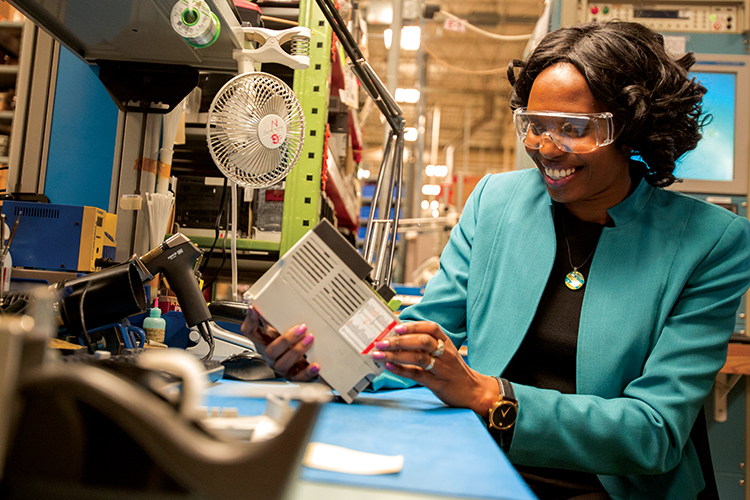
Renewable Horizons
Wilkistar Otieno helps companies get the most out of what they make.
Wilkistar Otieno is an expert in learning how something can be made better. And that even includes herself.
In 2010, in her early 30s, Otieno began running marathons. Now, the UWM industrial and manufacturing engineer has completed 30 full and half-marathons. Several mornings a week, be it warm or wintry, she’s out with the UWM Chancellor’s Running Group, renewing her efforts to beat a personal-best marathon time of 4 hours, 3 minutes. “Being on time for an early run starts my day on a good note,” Otieno says.
Otieno’s research, too, is about renewal. Her branch of engineering doesn’t focus on making things, but on studying how things are made. She puts a special focus on how products can be crafted so they’re more recyclable, and she designs remanufacturing processes that keep industrial pollutants out of sewerage systems and heavy electronics out of landfills.
“The more recyclable a piece is, the more remanufacturable it is,” explains Otieno, an associate professor in the College of Engineering & Applied Science. “You want to keep the whole thing out of the landfill if you can.”
In addition to helping the environment, remanufacturing helps Fortune 500 companies and their clients. Otieno’s work entails gathering data and analyzing manufacturing processes, then using that information to improve the process and product. Such expertise has led to working partnerships with top manufacturing companies like Rockwell Automation.
“We put nothing to waste,” says Michael Cook, director of the University Partnerships Program at Rockwell Automation. “When we talk about being a smart, safe, sustainable company, we have come to live and breathe that, becoming very serious and innovative with waste management and materials recycling.”
Otieno has created a model that helps companies and customers get more out of their products. Called the Analytical Hierarchical Performance Model, in simple terms, it determines whether companies and clients are better off creating a new product or a remanufactured one. While borrowing from previous performance models, Otieno has tweaked hers to focus more on the sustainability values that she shares with her research partners.

For example, one of Rockwell’s signature pieces of technology is the control drive, which directs a motor to move at a certain speed and frequency. Any company that has a conveyor system or uses hydraulics relies on a control drive, from mining companies to beverage bottling plants.
Drives can operate continuously for 20 to 30 years and cost anywhere from several hundred dollars to thousands of dollars. When they fail, some clients want their old drives repaired and returned – or “remanufactured.” A brand-new drive might be incompatible with older pieces of equipment that the company also relies on, or it might just be too expensive.
Otieno’s model factors in the economic, social, technical and energy implications of creating a new product versus remanufacturing an existing one. Different products require different levels of labor during the remanufacturing process. A control drive that’s welded shut must be sawed apart, and every screw in a case must be unscrewed, and each step adds to labor costs. In the end, Otieno’s model produces a numerical score that helps company engineers determine when remanufacturing is in their best interest and that of their clients.
“Remanufacturing is critically important to continuity of operations for our customers,” Cook says. “Some firms may not be ready from an economic or technical perspective to get the next-generation products. And Wilkistar certainly is able to understand the industrial perspective.”
The final phase of the performance-modeling process gets Otieno onto the plant floor, where she observes technicians as they make or remanufacture a product, analyzing the process and collecting anecdotal data. Her final report takes all of this into account, with an eye toward the consumer experience.
The concept of a “cradle-to-grave” product lifecycle is outdated, Otieno says. Looking at how a product moves from cradle to grave and “back to the cradle,” via remanufacturing, signals a new era of intelligent design.
“When a company maximizes utilization of their product,” Otieno says, “they gain customer loyalty and become more productive and efficient with less cost per unit. While I appreciate research that drives basic science to newer frontiers, I get a renewed sense of satisfaction when my work can have some benefit to a company.”